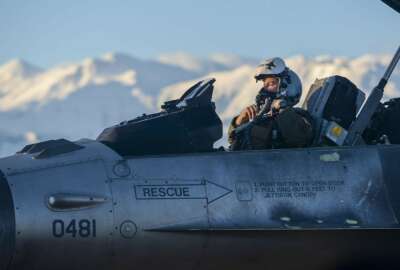
Air Force sets up task forces for big future changes
The Air Force is setting up three teams to look at squadrons, joint training and technology.
The Air Force is considering serious fundamental changes as a means to prepare for the 21st century.
That includes a possible change to the makeup and structure of Air Force squadrons, said Air Force Chief of Staff Gen. David Goldfein during a Sept. 20 speech.
Goldfein announced he would set up three task forces, which will work over the next four years to come up with answers for the Air Force.
Those task forces will focus on squadron structure and makeup, joint training and intelligence integration, Goldfein said during the Air Force Association Space and Cyber Conference in National Harbor, Md.
“We are going to go slow to go fast. These are each four-year efforts. They are each significant in scope and scale and each of them are going to require a partnership across the joint force, across the major commands, across the allies, with our industry partners. Each of these is a pretty significant effort,” Goldfein told reporters after his speech.
Goldfein said he resisted moving forward with the task forces until a written plan is created. Currently, each task force is assembling its team to write the plan. He added that the first task force to start, which focuses on squadron revitalization, will not start movement until January 2017.
The squadron task force will look into changing a unit that has been left largely the same for the past half century.
“When we talk about revitalizing squadrons we aren’t talking about taking money and manpower and throwing them at this issue, quite frankly we don’t have it. This is to step back and ask ourselves the fundamental question ‘What does a 21st-century squadron need to look like?’ I think it looks different. I think there may be a civilian/military mix to it. … we have one Air Force with three components that are joined at the hip and we ought to look at that at the squadron level and see if there is a different mix we ought to look at,” Goldfein said.
That’s about the only guidance Goldfein is giving the squadron task force, though. Goldfein said he does not want to set any expectations because that will squash creativity.
He said he has laid out why the Air Force needs the change, but the team is responsible for the “what” and the “how.”
The joint training task force will focus increasing the joint readiness of airmen. Goldfein said the Air Force is needed for all of the threats to the United States. It would pair with the Army in a conflict with Russia and primarily with the Navy in a conflict in the Pacific.
Goldfein said airmen are staying too long in their technical career fields because it takes them too long to get to the point of becoming instructors. That comes at the cost of joint training, though. The second task force will look into how to make joint training more ubiquitous and implement it earlier in Air Force careers.
The Air Force chief of staff also said he is worried about the way airmen are going into combat.
“I’m a bit concerned that over the last 15 years we have migrated into sending too many single airmen into combat for their first time,” Goldfein said. “I think the pendulum has swung a little too much into sending individual airmen into combat. What happens when you send an individual airman into combat is that single airman has go to through all the process and procedures to get themselves into the theater, join a team there, build the lexicon of the team they are joining and we do that very well and very quickly. But, I’m concern that now I’m in combat I have a significant combat experience and then I come home. … And the question I ask is who do I talk to? Who do I share my experiences with? Who can relate to what I’ve just gone through?… We are going to take a look into getting back into the business of deploying as teams.”
Those teams may only be as big as three airmen, but it will deploy together, employ together, redeploy together and reintegrate together, Goldfein said.
The final task force moves more away from personnel and into the technology realm. The third task for will be charged with fusing information from sensors, machines and other information architectures in new ways.
It’s almost a way of operationalizing the Defense Department’s third offset strategy — a push for more automated and man-machine technologies.
Goldfein said he will need industry’s help in making information connections better within the service and the military as a whole.
Copyright © 2025 Federal News Network. All rights reserved. This website is not intended for users located within the European Economic Area.
Scott Maucione is a defense reporter for Federal News Network and reports on human capital, workforce and the Defense Department at-large.
Follow @smaucioneWFED




